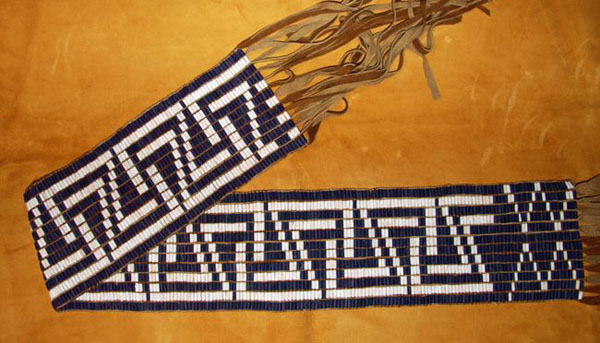Photographs (left to right): All Mohave Desert, California/Nevada
Wampum Belt Archive
Pledge of the Crown Belt
also known as the Claus Wampum Belt
(War 1812 Peace Wampum Belt)

(NMAI Belt 8386)

Reproduction (R. D. Hamell
March 28 2015
Original Size: |
Est. Length: 34.25 inches (Cordage) |
Reproduction: |
Beaded length: 39.0 inches. Width: 5.5 inches. Length w/fringe: 63.0 inches. |
Beads: |
Rows: 249 by 12 beads wide. Total: 2,988 beads. |
Materials: |
Warp: deer leather. Weave: artificial sinew. |
Description:
Excerpt from Carl Benn (1998)
"The end of hostilities between the two white powers did not lead automatically to peace between the divisions of the old Six Nations Confederacy. Therefore, the Iroquois of Grand River and of New York held a council at Fort George on 31 August and 1 September 1815 to negotiate peace between the two groups and between the king and the Iroquois in New York. At the council, they exchanged white wampum belts to formalized the end of hostilities and to symbolize that ill will had been removed from their hearts, thereby canceling the need to avenge the deaths suffered at each others' hands.They condoled with each other for their wartime losses and metaphorically buried 'the Tomahawk to the depth of a Pine Tree under ground. Both the Iroquois groups then went home loaded with British presents as gestures of the king's good will" (Carl Benn, (1998; p. 181).
Col. Claus presented this belt to the Six Nations after the War of 1812. It was a pledge by the Crown "not interfere in our culture or governance. It was given in 1815 and the minutes from that council still exist, but the belt was subsequent read by John Buck at Grand River with the meaning attached to it" (Rick Hill, 2011).
Seneca Belt (Six Nations Grand River, Canada). Chief Johnson recorded as the artist (Jan. 1, 1906). Represented the League of the Iroquois. No other information given (National Museum of American Indian).
My appreciation to Rick Hill for his kind assistance in reproduction this belt.
Excerpt from Gilkison (1928)
Gilkison (I928: 50) reported that of all the belts shown by John Skanawati Buck in 1887, this belt was "the largest and most showy, but least significant in its design. It was fully three feet and a half long and five inches wide and contained a groundwork of purple wampum with white worked in, forming a zig-zag pattern. This was given by Col. Claus on behalf of the Canadian Government, after he had studied the wampum records, at which he must have been looking and understood their significance. It was given as a token that the government would never force the Indians to change their customs." Krehbiel also saw this belt in 1892, writing that "a belt of purple containing a white conventionalized design like that commonly called the Greek key pattern (a meander) was said to have been sent by whites as a confirmation of a treaty" (cited in Beauchamp, 1901, p. 416).
Pledge of the Crown Wampum Belt (Steve Durand, 2016)
This wampum belt was created by the British to represent the ongoing relationship after the war. The pattern may have been derived from an ancient design called the meander, or Greek Key. It often was used to represent the interwoven bonds of love and friendship. Col. Claus stated:
This Belt which I now hand to you I ask in compliance with your Customs be sent by you with these my words in his behalf to all the Nations in friendship with your Great Father the King of England. . . I am further instructed to inform you that in making Peace with the Government of the United States of America, your interests were not neglected, nor would Peace have been made with them had they not consented to include you in the Treaty, which they at first refused to listen to. I will now repeat to you one of the Articles of the Treaty of Peace which secures to you the Peaceable Possession of all the Country which you possessed before the late War, and the Road is now open for you to pass and repass without interruption.
In 1877 Onondaga Chief John Buck, the Wampum Keeper at the time, stated that this belt represented a pledge by the Canadian government to never force the Haudenosaunee to change their customs.
References:
Benn, Carl. 1998. The Iroquois and War of 1812. University of Toronto Press, Scholarly Publishing Division, Edition 1, 288.
Beauchamp, 1901. Wampum and Shell Articles Used by the New York Indians. NYS Mus. Bull. 41, pp. 321-480.
Durand, Steve. 2016. https://www.facebook.com/photo.php?fbid=1188377717863152&set=gm.1687202218196800&type=3&theater
Gilkison, Augusta I. Grant. 1928. What Is Wampum? Explained by Chief John Buck. In Thirty-sixth Annual Archaeological Report, Being Part of Appendix to the Report of the Minister of Education, Ontario. Pp. 48-50.
Hill, Rick. 2011. Personal Communications.
National Museum of the American Indian Catalog.
Tooker, Elisabeth. 1998. A Note on the Return of Eleven Wampum Belts to the Six Nations Iroquois Confederacy on Grand River, Canada. Ethnohistory, Vol. 45, No. 2 (Spring), pp. 219-236.








